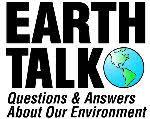What is the Safest Cookware?EARTH TALK
Dear EarthTalk: With the recent hubbub over the chemicals used to make Teflon linked to health problems, what is the safest cookware to use in preparing meals for my family?
-- Wyatt Walley, Needham, MA March 2006
When the health risks associated with making Teflon first came to light last year, many cooks trashed their non-stick cookware and went back to using their old stainless steel pots and pans. But what many people didn’t realize was that even stainless steel is not immune to controversy regarding health impacts.
In fact, stainless steel is really a mixture of several different metals, including nickel, chromium and molybdenum, all of which can trickle into foods. However, unless your stainless steel cookware is dinged and pitted, the amount of metals likely to get into your food is negligible.
These days, many health conscious cooks are turning to anodized aluminum cookware as a safer alternative. The electro-chemical anodizing process locks in the cookware’s base metal, aluminum, so that it can’t get into food, and makes for what many cooks consider an ideal non-stick and scratch-resistant cooking surface. Calphalon is the leading manufacturer of anodized aluminum cookware, but newer offerings from All Clad (endorsed by celebrity chef Emeril Lagasse) and others are coming on strong.
Another good choice is that old standby, cast iron, which is known for its durability and even heat distribution. Cast iron cookware can also help ensure that eaters in your house get enough iron--which the body needs to produce red blood cells--as it seeps off the cookware into food in small amounts. Unlike the metals that can come off of some other types of pots and pans, iron is considered a healthy food additive by the U.S. Food and Drug Administration. Consumers should beware, though, that most cast iron cookware needs to be seasoned after each use and as such is not as worry-free as other alternatives. Lodge Manufacturing is the leading American producer of cast iron cookware.
For those who like the feel and heat distribution properties of cast iron but dread the seasoning process, ceramic enameled cookware from Le Creuset, World Cuisine and others is a good choice. The smooth and colorful enamel is dishwasher-friendly and somewhat non-stick, and covers the entire surface of such cookware to minimize clean-up headaches. One other surface favored by chefs for sauces and sautés is copper, which excels at quick warm-ups and even heat distribution. Since copper can leak into food in large amounts when heated, the cooking surfaces are usually lined with tin or stainless steel.
But if you’re concerned about the build-up of solid waste in our landfills, don’t trash your non-stick cookware just yet. According to DuPont, the finished product of Teflon does not contain any of the production-process chemicals linked to health problems in factory workers. And the U.S. Environmental Protection Agency says that ingesting small particles of Teflon flaked off into food is not known to cause any health maladies. With proper use and care, such pots and pan--which constitute more than half of all cookware sales in the U.S.--should be safe to use for years to come. 
CONTACTS: Calphalon, www.calphalon.com; All-Clad, www.allclad.com, Lodge Manufacturing, www.lodgemfg.com; Le Creuset, www.lecreuset.com; World Cuisine, www.world-cuisine.com GOT AN ENVIRONMENTAL QUESTION? Send it to: EarthTalk, c/o E/The Environmental Magazine, P.O. Box 5098, Westport, CT 06881 USA; submit it at: www.emagazine.com/earthtalk/thisweek/; or e-mail: earthtalk@emagazine.com. | 